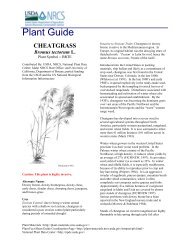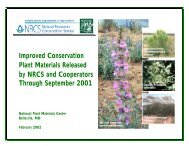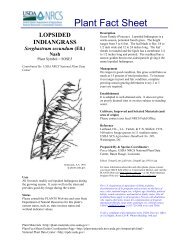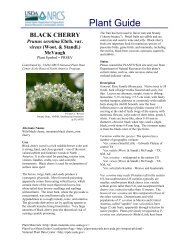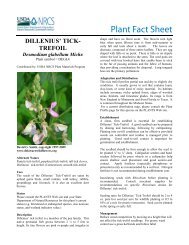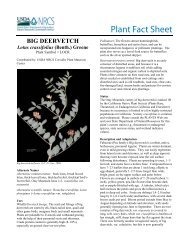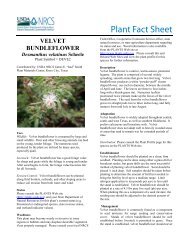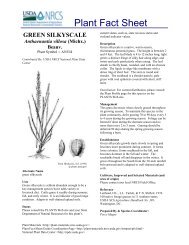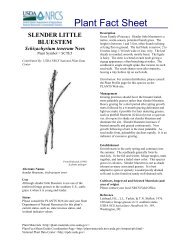Common Wooly Sunflower Plant Guide - USDA Plants Database
Common Wooly Sunflower Plant Guide - USDA Plants Database
Common Wooly Sunflower Plant Guide - USDA Plants Database
Create successful ePaper yourself
Turn your PDF publications into a flip-book with our unique Google optimized e-Paper software.
scales, therefore the seed is not wind-borne. Seed is<br />
retained on the flower head longer than many other<br />
Asteraceae species but will shatter within a week<br />
after ripening (Skinner 2007). A brush machine or<br />
hammer mill can be used to process the seed prior to<br />
cleaning with air screen equipment (Skinner 2007;<br />
Barner 2009). A gravity table may also be used to<br />
remove the remaining unfilled seed and inert<br />
material (Barner 2009). There are about 1,782,000<br />
seeds per kg (810,000 seeds per lb) (Lambert 2005).<br />
Experiments at the Pullman <strong>Plant</strong> Materials Center<br />
demonstrated an extended cold moist stratification<br />
period is needed to break seed dormancy. Skinner<br />
(2007) had 0% germination with no stratification,<br />
10% germination with 45 days stratification, and<br />
75% germination with 90 days stratification. Seed<br />
stratified longer than 90 days in the fluctuating spring<br />
temperatures achieved 82% germination. Some seed<br />
germinated during stratification, indicating<br />
germination will occur at low temperatures. Seed<br />
stored for 1 year in controlled conditions (5C and<br />
40% humidity) and sown without pretreatment failed<br />
to emerge (Skinner 2007). Mooring (2001) found<br />
seed viability decreased rapidly after 2 years of<br />
storage at room temperature, but some seed remained<br />
viable after 8 years.<br />
To produce seed of Eriophyllum lanatum, the Forest<br />
Service J. Herbert Stone Nursery sows seedbeds in<br />
the fall at a rate necessary to achieve 130 plants per<br />
square meter (12 plants per square foot) (Archibald<br />
2006). The seed is sown in bands 1.9 cm (0.75 in)<br />
deep, 3 cm (1.25 in) wide and 30 cm (12 in) apart<br />
with a modified Love/Oyjord® drill. Packing wheels<br />
are used to press the seed into the soil, and the seed is<br />
covered with 6 to 8 mm (0.25 to 0.33 in) of sawdust<br />
which is kept moist with irrigation until fall rains<br />
begin. Seed is harvested the following summer with<br />
a small plot combine, and the remaining plant residue<br />
is removed with a silage chopper. Seed yields have<br />
varied considerably depending on seedlot, growing<br />
season and age of the crop. A plot is typically<br />
harvested for a maximum of 5 years (Archibald<br />
2006).<br />
Cultivars, Improved, and Selected Materials (and<br />
area of origin)<br />
None, although seed and seedlings are available from<br />
several vendors.<br />
References<br />
Archibald, C. 2006. Seed production protocols for<br />
Anaphalis margaritacea, Eriophyllum lanataum<br />
and Eriogonum umbellatum. Native <strong>Plant</strong>s J.<br />
7:47-51.<br />
Barner, J. 2009. Propagation protocol for production<br />
of Eriophyllum lanatum (Pursh) Forbes seeds;<br />
<strong>USDA</strong> FS - R6 Bend Seed Extractory, Bend,<br />
OR. In: Native <strong>Plant</strong> Network. [Online]<br />
Available at: http://www.nativeplantnetwork.org<br />
(accessed 27 Jan 2011). University of Idaho,<br />
College of Natural Resources, Forest Research<br />
Nursery, Moscow, ID<br />
Burke Museum of Natural History and Culture.<br />
[Online]. Available at:<br />
http://biology.burke.washington.edu/herbarium/i<br />
magecollection.php (accessed 27 Jan 2010).<br />
University of Washington, Seattle, WA.<br />
Cane, J.H. 2005. Pollination needs of arrowleaf<br />
balsamroot, Balsamorhiza sagittata<br />
(Heliantheae: Asteraceae). Western North<br />
American Naturalist 65 (3): 359-364.<br />
Cane, J.H. 2011a. Specialist Osmia bees forage<br />
indiscriminately among hybridizing<br />
Balsamorhiza floral hosts.<br />
Oecologia (in press).<br />
Cane, J.H. 2011b. Personal communication.<br />
Charters, M.L. 2011. California <strong>Plant</strong> Names: Latin<br />
and Greek Meanings and Derivations. [Online]<br />
Available at:<br />
http://www.calflora.net/botanicalnames/<br />
(accessed 27 Jan 2011).<br />
Hitchcock, C.L. and A. Cronquist. 1973. Flora of the<br />
Pacific Northwest. University of Washington<br />
Press, Seattle and London.<br />
Knopf, A. A. 2001. National Audubon Society Field<br />
<strong>Guide</strong> to Wildflowers, Western Region.<br />
Chanticleer Press, New York, NY.<br />
Lady Bird Johnson Wildflower Center. 2011.<br />
[Online] Available at:<br />
http://www.wildflower.org/plants/result.php?id_<br />
plant=ERLA6 (Accessed 27 Jan 2011). Austin,<br />
TX.<br />
Lambert, S. 2005. <strong>Guide</strong>book to the Seeds of Native<br />
and Non-Native Grasses, Forbs and Shrubs of<br />
the Great Basin. Idaho BLM Technical Bulletin<br />
2005-04. USDI-BLM, Boise, ID.<br />
Lewis and Clark Herbarium. 2011. [Online]<br />
Available at:<br />
http://www.plantsystematics.org/reveal/pbio/Ln<br />
C/LnCpublic4.html (Accessed 27 Jan 2011).<br />
Cornell University, Ithaca, NY, and University<br />
of Maryland, College Park, MD.<br />
Lyons, C.P. and B. Merilees. 1995. Trees, Shrubs and<br />
Flowers to Know in Washington and British<br />
Columbia. Lone Pine Press, Auburn, WA,<br />
Vancouver, BC, and Edmonton, AB.<br />
Mooring, J.S. 1975. A cytogeographic study of<br />
Eriophyllum lanatum (Compositae, Helenieae).<br />
Amer. J. Bot. 62(10):1027-1037.<br />
Mooring, J.S. 2001. Barriers to interbreeding in the<br />
Eriophyllum lanatum (Asteraceae, Helenieae)<br />
species complex. Amer. J. Bot. 88(2):285-312.<br />
Native American Ethnobotany <strong>Database</strong>. 2011.<br />
[Online] Available at http://herb.umd.umich.edu/<br />
(Accessed 27 Jan 2011). University of Michigan,<br />
Dearborn, MI.



